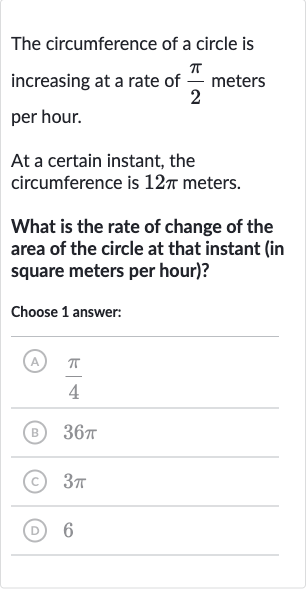AI tutor
Welcome to Bytelearn!
Let’s check out your problem:

The circumference of a circle is increasing at a rate of meters per hour.At a certain instant, the circumference is meters.What is the rate of change of the area of the circle at that instant (in square meters per hour)?Choose answer:(A) (B) (C) (D)
Full solution
Q. The circumference of a circle is increasing at a rate of meters per hour.At a certain instant, the circumference is meters.What is the rate of change of the area of the circle at that instant (in square meters per hour)?Choose answer:(A) (B) (C) (D)
- Find Circle Radius: First, let's find the radius of the circle using the circumference. The formula for circumference is , where is the circumference and is the radius.
- Calculate Rate of Change: Given , we can solve for : . Dividing both sides by , we get meters.
- Derivative of Area: Now, we need to find the rate of change of the area. The area of a circle is given by . To find the rate of change of the area, we'll use the derivative , where is the rate of change of the radius.
- Rate of Change Calculation: We know the circumference is increasing at a rate of meters per hour, which means the radius is increasing at a rate of meters per hour because .
- Correcting Mistake: Substitute meters and meters per hour into the derivative of the area: .
- Correcting Mistake: Substitute meters and meters per hour into the derivative of the area: .Simplify the expression: meters squared per hour.
- Correcting Mistake: Substitute meters and meters per hour into the derivative of the area: .Simplify the expression: meters squared per hour.So, the rate of change of the area of the circle at that instant is square meters per hour. But wait, there's a mistake here. We should not have squared in the final answer. Let's correct it.
More problems from Area of quadrilaterals and triangles: word problems
QuestionGet tutor help
QuestionGet tutor help
QuestionGet tutor help
QuestionGet tutor help
QuestionGet tutor help
QuestionGet tutor help
QuestionGet tutor help
